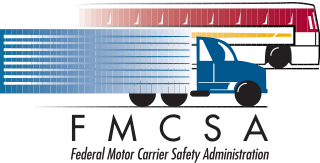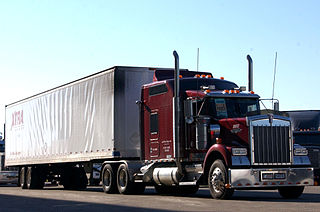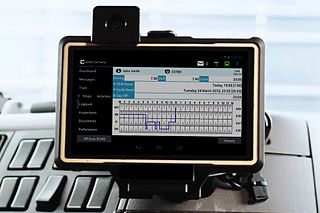A broadcast flag is a bit field sent in the data stream of a digital television program that indicates whether or not the data stream can be recorded, or if there are any restrictions on recorded content. Possible restrictions include the inability to save an unencrypted digital program to a hard disk or other non-volatile storage, inability to make secondary copies of recorded content, forceful reduction of quality when recording, and inability to skip over commercials.

An ignition interlock device or breath alcohol ignition interlock device is a breathalyzer for an individual's vehicle. It requires the driver to blow into a mouthpiece on the device before starting or continuing to operate the vehicle. If the resultant breath-alcohol concentration analyzed result is greater than the programmed blood alcohol concentration, the device prevents the engine from being started. The interlock device is located inside the vehicle, near the driver’s seat, and is directly connected to the engine’s ignition system. It is a form of electronic monitoring.

A tachograph is a device fitted to a vehicle that automatically records its speed and distance, together with the driver's activity selected from a choice of modes. The drive mode is activated automatically when the vehicle is in motion, and modern tachograph heads usually default to the other work mode upon coming to rest. The rest and availability modes can be manually selected by the driver whilst stationary.

A logbook is a record used to record states, events, or conditions applicable to complex machines or the personnel who operate them. Logbooks are commonly associated with the operation of aircraft, nuclear plants, particle accelerators, and ships.

On-board diagnostics (OBD) is a term referring to a vehicle's self-diagnostic and reporting capability. In the United States, this self diagnostic is a requirement to comply with Federal Emissions standards to detect failures that may increase the vehicle tailpipe emissions to more than 150% of the standard to which it was originally certified.

A truck driver is a person who earns a living as the driver of a truck, which is commonly defined as a large goods vehicle (LGV) or heavy goods vehicle (HGV).

Vehicle and Operator Services Agency (VOSA) was an executive agency granted trading fund status in the United Kingdom sponsored by the Department for Transport of the United Kingdom Government.
Fleet management is the management of:

A weigh station is a checkpoint along a highway to inspect vehicular weights and safety compliance criteria. Usually, trucks and commercial vehicles are subject to the inspection.
An event data recorder (EDR), more specifically motor vehicle event data recorder (MVEDR), similar to an accident data recorder, (ADR) sometimes referred to informally as an automotive black box, is a device installed in some automobiles to record information related to traffic collisions. In the USA EDRs must meet federal standards, as described within the U.S. Code of Federal Regulations.

The Federal Motor Carrier Safety Administration (FMCSA) is an agency in the United States Department of Transportation that regulates the trucking industry in the United States. The primary mission of the FMCSA is to reduce crashes, injuries, and fatalities involving large trucks and buses.
PrePass is an intelligent transportation system (ITS) that electronically verifies the safety, credentials, and weight of commercial vehicles as they approach participating state highway weigh stations. Because they comply electronically, commercial carriers enrolled in PrePass are authorized to bypass these facilities rather than pull in for manual inspection.

Hours of Service (HOS) regulations are issued by the Federal Motor Carrier Safety Administration (FMCSA) and govern the working hours of anyone operating a commercial motor vehicle (CMV) in the United States. These regulations apply to truck drivers, commercial and intercity bus drivers, and school bus drivers who operate CMVs. These rules limit the number of daily and weekly hours spent driving and working, and regulate the minimum amount of time drivers must spend resting between driving shifts. For intrastate commerce, the respective state's regulations apply.

The trucking industry serves the American economy by transporting large quantities of raw materials, works in process, and finished goods over land—typically from manufacturing plants to retail distribution centers. Trucks are also used in the construction industry, two of which require dump trucks and portable concrete mixers to move the large amounts of rocks, dirt, concrete, and other building materials used in construction. Trucks in America are responsible for the majority of freight movement over land and are tools in the manufacturing, transportation, and warehousing industries.

An electronic on-board recorder (EOBR) is an electronic device attached to a commercial motor vehicle, which is used to record the amount of time a vehicle is being driven. This is similar to the tachograph, and is the American equivalent of the digital tachograph used in Europe. Trucks in the European Union are required to have digital tachographs installed, and are securely monitored by government agencies. However, in Europe, the new digital tachograph which is considered secure, can be tricked with a round magnet placed by drivers over the connection to the transmission box. Usually they tie a rope to that magnet, and with a simple pull, the magnet will disengage and will show that the driver started moving about half an hour ago . The majority of carriers and drivers in the United States currently use paper-based log books. On January 31, 2011, the U.S. Federal Motor Carrier Safety Administration (FMCSA) proposed a rule requiring Electronic On-Board Recorders for interstate commercial truck and bus companies. The proposed rule covers interstate carriers that currently use log books to record driver's hours of service. The proposal would affect more than 500,000 carriers in the United States and carriers that currently use time cards would be exempt.
The motor carrier safety rating is an evaluation given to an interstate commercial motor carrier by the Federal Motor Carrier Safety Administration (FMCSA).

Lytx is a San Diego, California based technology company that designs, manufactures and sells video telematics products used by commercial and public-sector fleets to help improve driver safety and business productivity. Products include risk detection, fleet tracking, and driver safety programs that use artificial intelligence and analysts to identify risky driving behaviors and report real-time fleet information. The company's clients include waste management and sanitation companies, trucking and distribution, government and municipality vehicles, passenger transit, construction, utilities, telecom and field services. Lytx also provides compliance services for trucking fleets regulated by the U.S. Department of Transportation.

A digital tachograph is a device fitted to a vehicle that digitally records its speed and distance, together with the driver's activity selected from a choice of modes.

People who are driving as part of their work duties are an important road user category. First, workers themselves are at risk of road traffic injury. Contributing factors include fatigue and long work hours, delivery pressures, distractions from mobile phones and other devices, lack of training to operate the assigned vehicle, vehicle defects, use of prescription and non-prescription medications, medical conditions, and poor journey planning. Death, disability, or injury of a family wage earner due to road traffic injury, in addition to causing emotional pain and suffering, creates economic hardship for the injured worker and family members that may persist well beyond the event itself.
Drivewyze is an intelligent transportation system (ITS) service that provides bypasses to commercial vehicles as they approach participating state highway weigh stations. The participating vehicles' safety record, credentials and weight are verified automatically, and if they comply with that state's screening rules for automated bypass, the vehicles are authorized to bypass these facilities rather than pull in for manual inspection. This results in time and fuel savings for the truck and less vehicle congestion at the weigh station.













